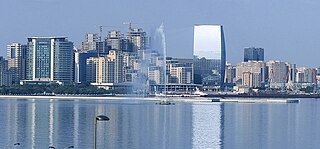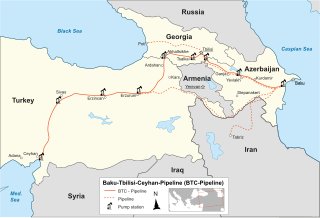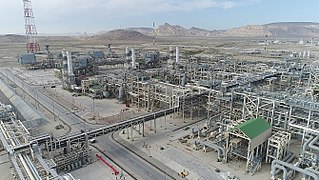
Rena Effendi (born 1977) [1] is an Azerbaijani freelance photographer. Her work focuses on themes of environment, post-conflict society, the effects of oil industry on people, and social disparity.

Rena Effendi (born 1977) [1] is an Azerbaijani freelance photographer. Her work focuses on themes of environment, post-conflict society, the effects of oil industry on people, and social disparity.
Effendi was born in 1977 in Baku. She studied linguistics at the Azerbaijan State Institute of Languages. [1]
Effendi began photographing in 2001 and became a full-time photographer in 2005 after quitting her job as an Economic Development Specialist at the United States Agency for International Development in Baku. Effendi's first monograph Pipe Dreams, published by Mets & Schilt, focuses on how the oil industry affected the lives of ordinary citizens in Azerbaijan, Georgia and Turkey along the Baku–Tbilisi–Ceyhan pipeline. She initially got a commercial assignment from BP, the oil consortium that operates this pipeline from Azerbaijan via Georgia to the southern Turkish port of Ceyhan. While photographing this promotional material, she discovered that just a small percentage of the urban population in her country is benefiting from the oil boom. Over the course of 6 years this work was turned into Pipe Dreams. [2] [3]
Effendi has also produced stories in Chernobyl after the nuclear disaster of 1986, transgender people in Istanbul, village life in Khinalug, the Russia–Georgia war of 2008, life of youth in Tehran, Russia, and Cairo. [2] She published this work in 2010 by the title of Chernobyl: Still Life in the Zone. In the work she decided to showcase people's life in the zone instead of a memento. [4]
Her work has been published in the International Herald Tribune , Newsweek , Financial Times , Time Magazine , National Geographic , Marie Claire , Courrier International , Le Monde and L'Uomo Vogue . [5] Her work has also been shown at the Saatchi Gallery in London, Aperture Gallery in New York, Istanbul Modern, Venice Biennial and Art Basel. [3]
Effendi has won the Fifty Crows Documentary Award, the Mario Giacomelli Memorial Award and the Getty Images Editorial Grant. [5] In 2008, National Geographic Magazine honored her with an All Roads Photography Award, in 2009 she received the Young Photographer in the Caucasus Award, and in 2011 she won a Prince Claus Award. [5] [6] She won 3rd prize in the Observed Portraits category at the 2014 World Press Photo Contest, Amsterdam, Netherlands for "Transylvania: Built on Grass". [7]

The economy of Azerbaijan is highly dependent on oil and gas exports, in particular since the completion of the Baku-Tbilisi-Ceyhan Pipeline. The transition to oil production in the late 1990s led to rapid economic growth over the period 1995–2014. Since 2014, GDP growth has slowed down substantially.

The Baku–Tbilisi–Ceyhan (BTC) pipeline is a 1,768 kilometres (1,099 mi) long crude oil pipeline from the Azeri–Chirag–Gunashli oil field in the Caspian Sea to the Mediterranean Sea. It connects Baku, the capital of Azerbaijan and Ceyhan, a port on the south-eastern Mediterranean coast of Turkey, via Tbilisi, the capital of Georgia. It is the second-longest oil pipeline in the former Soviet Union, after the Druzhba pipeline. The first oil that was pumped from the Baku end of the pipeline reached Ceyhan on 28 May 2006.

The Burgas–Alexandroupoli pipeline was a proposed oil pipeline project for transportation of Russian and Caspian oil from the Bulgarian Black Sea port of Burgas to the Greek Aegean port of Alexandroupoli. It was seen as an alternative route for Russian oil, bypassing the Bosporus and the Dardanelles. However, in December 2011 the project was suspended by the Bulgarian government due to environmental and supply concerns.

The Ünye–Ceyhan pipeline, commonly known with its former name, the Samsun–Ceyhan pipeline, was a planned crude oil pipeline traversing Turkey from the Black Sea to the Mediterranean oil terminal in Ceyhan. The aim of the project was to provide an alternative route for Russian and Kazakhstani oil and to ease the traffic burden in the Bosporus and the Dardanelles. The project was halted in 2010. This was confirmed again in 2013.

The petroleum industry in Azerbaijan produces about 873,260 barrels (138,837 m3) of oil per day and 29 billion cubic meters of gas per year as of 2013. Azerbaijan is one of the birthplaces of the oil industry.
Azeri–Chirag–Gunashli or Azeri–Chirag–Deepwater Gunashli is a complex of oil fields in the Caspian Sea, about 120 kilometres (75 mi) off the coast of Azerbaijan. It consists of the Azeri and Chirag oil fields, and the deepwater portion of the Gunashli oil field. An overall estimate of the area of the development is 432.4 square kilometres (167.0 sq mi). It is developed by the Azerbaijan International Operating Company, a consortium of international oil companies, and operated by BP on behalf of the consortium. The ACG fields have estimated recoverable reserves of about 5 to 6 billion barrels of petroleum. Peak oil production of 835,000 barrels per day (132,800 m3/d) was reached in 2010, however by the first quarter of 2022 production had declined to 434,000 barrels per day (69,000 m3/d), or about one-half of peak value. As of 2021, ACG oil accounted for 95% of all Azerbaijani oil exports.
Thomas Goltz was an American author and journalist best known for his accounts of conflict in the Caucasus region during the 1990s. He spent 15 years in and around Turkey and the Caucasus.

Türkiye Petrolleri Anonim Ortaklığı (TPAO) was founded in 1954 by Law No. 6327 with the responsibility of being involved in hydrocarbon exploration, drilling, production, refinery and marketing activities of oil and gas in Turkey as the national company.
Svante E. Cornell is a Swedish scholar specializing on politics and security issues in Eurasia, especially the South Caucasus, Turkey, and Central Asia. He is a director and co-founder of the Stockholm-based Institute for Security and Development Policy (ISDP), and Research Director of the Central Asia-Caucasus Institute & Silk Road Studies Program (CACI), and joined the American Foreign Policy Council as a Senior Fellow for Eurasia in January 2017.

The Sangachal Terminal is an industrial complex consisting of a natural gas processing plant and oil production plant, located on the coast of the Caspian Sea 45 kilometres (28 mi) south of Baku, Azerbaijan.

The Baku–Supsa Pipeline is an 833-kilometre (518 mi) long oil pipeline, which runs from the Sangachal Terminal near Baku to the Supsa terminal in Georgia. It transports oil from the Azeri-Chirag-Guneshli field. The pipeline is operated by BP.

The Baku–Novorossiysk pipeline is an 1,330-kilometre (830 mi) long oil pipeline, which runs from the Sangachal Terminal near Baku to the Novorossiysk terminal at the Black Sea coast in Russia. The Azerbaijani section of the pipeline is operated by the State Oil Company of Azerbaijan Republic (SOCAR) and the Russian section is operated by Transneft.
Sanqaçal is a settlement and municipality in Baku, Azerbaijan. It has a population of 4,108.
The Mozdok–Makhachkala–Kazi Magomed pipeline is a natural gas pipeline from Mozdok in North Ossetia through Chechnya and Dagestan to Azerbaijan. The Azerbaijani section is also known as the Kazi Magomed–Novo Filya or Baku–Novo Filya, and it connects Baku with the Novo Filya gas metering utility on the Russian side of the Azerbaijan-Russia border. The pipeline will be used for transportation of Azerbaijani gas to Russia starting from 1 January 2010.
Chirag is an offshore oil field in the Caspian Sea, located 120 km (75 mi) east of Baku, Azerbaijan, and is a part of the larger Azeri-Chirag-Guneshli (ACG) project. The production, drilling and quarters (PDQ) platform Chirag 1 (EOP) has been in operation since 1997. Chirag 1 has been producing the Early Oil from the ACG field. West Chirag is planned as an extension of ACG project.
Azeri is an offshore oil field in the Caspian Sea, located 100 km (62 mi) east of Baku, Azerbaijan and is a part of the larger Azeri-Chirag-Guneshli (ACG) project. The Azeri field includes Central Azeri, West Azeri, East Azeri production platforms compression and water injection platform (C&WP). The field was discovered in 1988, and originally it was named after 26 Baku Commissars.
Gunashli is an offshore oil field in the Caspian Sea, located 120 kilometres (75 mi) east of Baku, Azerbaijan, 12 kilometres (7.5 mi) southeast of Oil Rocks and its deep water section is a part of the larger Azeri–Chirag–Gunashli (ACG) project. The Azerbaijani translation of Gunashli means "sunny". Gunashli is believed to have more than 100 million tonnes of oil reserves.

The Leyla-Tepe culture of the South Caucasus belongs to the Chalcolithic era. It got its name from the site in the Agdam District of modern-day Azerbaijan. Its settlements were distributed on the southern slopes of Central Caucasus, from 4350 until 4000 B.C.
Impressions Gallery is an independent contemporary photography gallery in Bradford, England. It was established in 1972 and located in York until moving to Bradford in 2007. Impressions Gallery also runs a photography bookshop, publishes its own books and sells prints. It is one of the oldest venues for contemporary photography in Europe.
The following is a timeline of the history of the city of Baku, Azerbaijan.